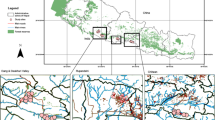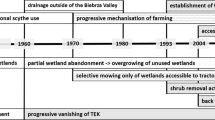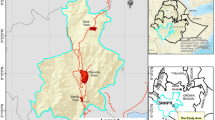Abstract
Soils developed on banded iron formations (BIFs) present severe physical and chemical limitations to the establishment and growth of non-native cultivated plants. In Brazil, these areas are extensively exploited by Fe and Al mining, causing impacts that further hamper the growth of plant species for the purpose of ecological restoration or rehabilitation. However, traditional communities have historically managed this type of environment successfully for subsistence crops. An understanding of the methods used for such purpose will help future studies of land-use diversification and rehabilitation in these ferruginous soils. The aim of this study was to investigate the traditional ecological knowledge (TEK) of a community with great cultural richness inhabiting areas on BIFs in Ouro Preto, Brazil. Interviewees were selected by the snowball technique. Ethnoecological methods (interviews, free lists and guided visits) were used to record the types of soil management, cultivated species and socioeconomic profile of specialists. Specialists are mainly women over 45 years old, low schooling, born and living in the area for a long period. Trial and error and vertical transmission represent the main forms of TEK acquisition. There was high diversity of praxis in the ecological soil management, as well as of cultivated species (183). The methods used are efficient for the physical and chemical soil improvement, allowing the establishment of species, increasing agrobiodiversity and diversifying land use. The used techniques can provide technologies for the rehabilitation of mined areas, confirming the importance of ethnoecological studies for this purpose.




Similar content being viewed by others
References
Adriano, D. C., Wenzel, W. W., Vangronsveld, J., & Bolan, N. S. (2004). Role of assisted natural remediation in environmental cleanup. Geoderma, 122, 121–142. https://doi.org/10.1016/j.geoderma.2004.01.003.
Albuquerque, U. P. (1999). Manejo tradicional de plantas em regiões neotropicais. Acta Botanica Brasilica, 13, 307–315.
Albuquerque, U. P., Paiva de Lucena, R. F., & Cunha, L. V. F. C. (2010). Métodos e técnicas na pesquisa etnobiológica e etnoecológica. Recife: NUPPEA.
Alleoni, L. R. F., Iglesias, C. S. M., Mello, S. C., Camargo, O. A., Casagrande, J. C., & Lavorenti, N. A. (2005). Atributos do solo relacionados à adsorção de cádmio e cobre em solos tropicais. Acta Scientiarum Agronomy, 27, 729–737. https://doi.org/10.4025/actasciagron.v27i4.1348.
Altieri, M. A. (2002). Agroecology: the science of natural resource management for poor farmers in marginal environments. Agriculture, Ecosystems & Environment, 93, 1–24. https://doi.org/10.1016/S0167-8809(02)00085-3.
Altieri, M. A. (2004). Agroecologia: A dinâmica produtiva da agricultura sustentável. Porto Alegre: UFRGS.
Altieri, M. A., Silva, E. N., & Nicholls, C. I. (2003). O papel da biodiversidade no manejo de pragas. Riberão Preto: Holos.
Angel-Pérez, A. L., & Mendoza, M. A. (2004). Totonac homegardens and natural resources in Veracruz, Mexico. Agriculture and Human Values, 21, 329–346. https://doi.org/10.1007/s10460-004-1219-9.
Barboza, E., Moline, E. F. V., Schlindwein, J. A., Farias, E. A. P., & Brasilino, M. F. (2011). Fertilidade de Solos. Enciclopédia Biosfera, Centro Científico Conhecer - Goiânia, 7, 586–594.
Benites, V. M., Caiafa, A. N., Mendonça, E. S., Schaefer, C. E., & Ker, J. C. (2003). Solos e vegetação nos complexos rupestres de altitude da Mantiqueira e do Espinhaço. FLORAM, 10, 76–85.
Benites, V. M., Scheafer, C. E., Simas, F. N. B., & Santos, H. G. (2007). Soils associated with rock outcrops in the Brazilian mountain ranges Mantiqueira and Espinhaço. Revista Brasileira de Botânica, 30, 569–577. https://doi.org/10.1590/S0100-84042007000400003.
Bickman, L., & Rog, D. J. (1998). Handbook of applied social research methods. London: SAGE Publications.
Brady, N. C., & Weil, R. R. (2013). Elementos da Natureza e Propriedades dos Solos. Porto Alegre: Bookman.
Carmo, F. F., Carmo, F. F., Campos, I. C., & Jacobi, C. M. (2012). Cangas ilhas de ferro estratégicas para a conservação. Ciência Hoje, 50, 49–53.
Carmo, F. F., et al. (2017). Fundão tailings dam failures: The environment tragedy of the largest technological disaster of Brazilian mining in global context. Perspectives in Ecology and Conservation, 15, 145–151. https://doi.org/10.1016/j.pecon.2017.06.002.
Dewaelheyns, V., Elsen, A., Vandendriessche, H., & Gulinck, H. (2013). Garden management and soil fertility in flemish domestic gardens. Landscape and Urban Planning, 116, 25–35. https://doi.org/10.1016/j.landurbplan.2013.03.010.
Dias, D. D. (2017). Recrutamento e estabelecimento de plantas após transposição de topsoil para área degradada pela mineração de bauxita. Federal University of Ouro Preto. Master Thesis. https://www.repositorio.ufop.br/handle/123456789/9666
Dikinya, O., & Mufwanzala, N. (2010). Chicken manure—enhanced soil fertility and productivity: Effects of application rates. Journal of Soil Science and Environmental Management, 1, 46–54.
EMBRAPA. (1997). Manual de Métodos de Análise de Solo. Rio de Janeiro: Centro Nacional de Pesquisa de Solos.
Engle, P. L., & Black, M. M. (2008). The effect of poverty on child development and educational outcomes. Annals of the New York Academy of Sciences, 1136, 243–256. https://doi.org/10.1196/annals.1425.023.
Fernandes, G. W., et al. (2016). Deep into the mud: Ecological and socio-economic impacts of the dam breach in Mariana, Brazil. Natureza & Conservação, 14, 35–45. https://doi.org/10.1016/j.ncon.2016.10.003.
Ferreira, M. C., & Vieira, D. L. M. (2017). Topsoil for restoration: Resprouting of root fragments and germination of pioneers trigger tropical dry forest regeneration. Ecological Engineering, 103, 1–12. https://doi.org/10.1016/j.ecoleng.2017.03.006.
Fess, T. L., & Benedito, V. A. (2018). Organic versus conventional cropping sustainability: A comparative system analysis. Sustainability, 10(1), 272. https://doi.org/10.3390/su10010272.
Figueiredo, M. A., Leite, M. G. P., & Kozovits, A. R. (2016). Influence of soil texture on nutrients and potentially hazardous elements in Eremanthus erythropappus. International Journal of Phytoremediation, 18, 487–493. https://doi.org/10.1080/15226514.2015.1115961.
Gagen, E. J., Levett, A., Paz, A., Gastauer, M., Caldeira, C. F., Valadares, R. B. D. S., et al. (2019). Biogeochemical processes in canga ecosystems: Armoring of iron ore against erosion and importance in iron duricrust restoration in Brazil. Ore Geology Reviews, 107, 573–586. https://doi.org/10.1016/j.oregeorev.2019.03.013.
GFT. (2016). Avaliação dos efeitos e desdobramentos do rompimento da Barragem de Fundão em Mariana-MG. Governo de Minas Gerais, Secretária de estado de desenvolvimento regional, política urbana e gestão metropolitana, Belo Horizonte
Gibson, N., Yates, C. J., & Dillon, R. (2010). Plant communities of the ironstone ranges of South Western Australia: Hotspots for plant diversity and mineral deposits. Biodiversity and Conservation, 19, 3951–3962. https://doi.org/10.1007/s10531-010-9939-1.
Guimarães, M. F. M. (2016). Plantas úteis em comunidades urbanas: A importância das espécies exóticas e do gênero na manutenção do conhecimento e uso dos recursos vegetais. Mestrado: Universidade Federal de Ouro Preto.
Harmon, G. W., & Keim, F. D. (1934). Percentage and viability of weed seeds recovered in the feces of farm animals and their longevity when buried in manure. American Society of Agronomy, 26, 762–767.
Hopper, S. D. (2009). OCBIL theory: Towards an integrated understanding of the evolution, ecology and conservation of biodiversity on old, climatically buffered, infertile landscapes. Plant and Soil, 322, 49–86. https://doi.org/10.1007/s11104-009-0068-0.
Howard, P. (2003). The Major Importance of minor resources: Women and plant biodiversity. International Institute for Environment and Development Gatekeeper Series No. 112, London.
Howard, P. (2006). Gender and social dynamics in swidden and homegardens in Latin America. In B. M. Kumar & P. K. R. Nair (Eds.), Tropical Homegardens: A time-tested example of sustainable agroforestry (Vol. 3, pp. 159–182). Dordrecht: Springer.
IBGE. (2015). Estimativas da população dos municipios e unidades da federação brasileiros. https://www.ibge.gov.br/estatisticas-novoportal/por-cidade-estado-estatisticas. Accessed 25 June 2017.
Iii, A. P. G. (2009). An update of the angiosperm phylogeny group classification for the orders and families of flowering plants: APG III. Botanical Journal of the Linnean Society, 161, 105–121.
Jacobi, C. M., & Carmo, F. F. (2008a). The contribution of ironstone outcrops to plant diversity in the Iron Quadrangle, a threatened Brazilian landscape. Ambio, 37, 324–326. https://doi.org/10.1579/0044-7447(2008)37%5b324:tcoiot%5d2.0.co;2.
Jacobi, C. M., & Carmo, F. F. (2008b). Diversidade dos campos rupestres ferruginosos no Quadrilátero Ferrífero, MG. Megadiversidade, 4, 25–33.
Jacobi, C. M., Carmo, F. F., Vincent, R. C., & Stehmann, J. R. (2007). Plant communities on ironstone outcrops: A diverse and endangered Brazilian ecosystem. Biodiversity and Conservation, 16, 2185–2200. https://doi.org/10.1007/s10531-007-9156-8.
Jensen, M. (1993). Soil conditions, vegetation structure and biomass of a Javanese homegarden. Agroforestry Systems, 24, 171–186.
Jose, D., & Shanmugaratnam, N. (1993). Traditional homegardens of Kerala: A sustainable human ecosystem. Agroforestry Systems, 24, 203–213.
Keskinen, R., Saastamoinen, M., Nikama, J., Särkijärvi, S., Myllymäki, M., Salo, T., et al. (2017). Recycling nutrients from hourse manure: Effects of bedding type its compostability. Agricultural and Food Science, 26, 68–79.
Kumar, B. M., & Nair, P. K. R. (2004). The enigma of tropical homegardens. Agroforestry Systems, 61, 135–152. https://doi.org/10.1023/B:AGFO.0000028995.13227.ca.
Lashomb, J. H., & Yuen-Shaung, N. G. (1984). Colonization by colorado potato beetles, Leptinotarsa decemlineata (Say) (Coleoptera: Chrysomelidae), in rotated and nonrotated potato fields. Environmental Entomology, 13, 1352–1356.
Le Stradic, S., et al. (2016). Comparison of translocation methods to conserve metallophyte communities in the Southeastern D.R. Congo. Environmental Science and Pollution Research International, 23, 13681–13692. https://doi.org/10.1007/s11356-015-5548-6.
Mace, G. M., Norris, K., & Fitter, A. H. (2012). Biodiversity and ecosystem services: a multilayered relationship. Trends in Ecology & Evolution, 27, 19–26.
Machado, N. A., Leite, M. G., Figueiredo, M. A., Leite, G. P., Figueiredo, M. A., & Kozovits, A. R. (2013). Growing Eremanthus erythropappus in crushed laterite: A promising alternative to topsoil for bauxite-mine revegetation. Journal of Environmental Management, 129, 149–156.
Mair, J., & Marti, I. (2008). Entrepreneurship in and around institutional voids: A case study from Bangladesh. Journal of Business Venturing, 24, 419–435. https://doi.org/10.1016/j.jbusvent.2008.04.006.
Mallmann, F. J. K., Miotto, A., Santana, N. A., & Jacques, R. J. S. (2016). Manejos indicados pela pesquisa para mitigar o excesso de metais pesados nos solos do sul do Brasil. In T. Tiecher (Ed.), Manejo e conservação do solo e da água em pequenas propriedades rurais no sul do Brasil: práticas alternativas de manejo visando a conservação do solo e da água (pp. 118–140). Porto Alegre: UFRGS.
Marciel, R., Giacomini, S. J., Ferreira, P. A. A., & Eckhardt, D. P. (2016). Plantas de cobertura de solo e agricultura sustentável: espécies, matéria seca e ciclagem de carbono e nitrogênio. In T. Tiecher (Ed.), Manejo e conservação do solo e da água em pequenas propriedades rurais no sul do Brasil: práticas alternativas de manejo visando a conservação do solo e da água (pp. 7–22). Porto Alegre, Rio Grande do Sul: UFRGS.
Meirelles, S. T., Pivello, V. R., & Joly, C. A. (1999). The vegetation of granite rock outcrops in Rio de Janeiro, Brazil, and the need for its protection. Environmental Conservation, 26, 10–20.
Messias, M. C. T. B., & Carmo, F. F. (2015). Flora e vegetação em substratos ferruginosos do Sudeste do Quadrilátero Ferrífero. In F. F. Carmo, & L. H. Y. Kamino (orgs.), Geossistemas Ferruginosos no Brasil (pp. 335–360). Instituto Prístino, Belo Horizonte.
Messias, M. C. T. B., Leite, M. G. P., Meira-Neto, J. A. A., & Kozovits, A. R. (2011). Life-form spectra of quartzite and itabirite rocky outcrop sites, Minas Gerais, Brazil. Biota Neotropica, 11, 1–14.
Messias, M. C. T. B., Menegatto, M. F., Prado, A. C. C., Santos, B. R., & Guimarães, M. F. M. (2015). Uso popular de plantas medicinais e perfil socioeconômico dos usuários: Um estudo em área urbana em Ouro Preto, MG, Brasil. Revista Brasileira de Plantas Medicinais, 17, 76–104. https://doi.org/10.1590/1983-084X/12_139.
Mikulcak, F., Newig, J., Milcu, A. I., Hartel, T., & Fischer, J. (2013). Integrating rural development and biodiversity conservation in Central Romania. Environmental Conservation, 40, 129–137. https://doi.org/10.1017/S0376892912000392.
Miller, R. P., Penn, J. W., & Leeuwen, J. (2006). Amazonian homegardens: Their ethnohistory and potential contribution to agroforestry development. In B. M. Kumar & P. K. R. Nair (Eds.), Tropical Homegardens: A time-tested example of sustainable agroforestry (Vol. 3, pp. 43–60). Dordrecht: Springer.
Nair, P. K. R. (1993). An introduction to agroforestry. Dordrecht: Kluwer Academic Publishers, ICRAF.
Nellemann, C., & Corcoran, E. (Eds.). (2010). Dead planet, living planet—Biodiversity and ecosystem restoration for sustainable development. Nairobi: United Nations Environment Programme.
Neves, A. C. O., Nunes, F. P., Carvalho, F. A., & Fernandes, G. W. (2016). Neglect of ecosystems services by mining, and the worst environmental disaster in Brazil. Natureza & Conservação, 14, 24–27. https://doi.org/10.1016/j.ncon.2016.03.002.
Oliveira, P. D., Ambrosini, V. G., Melo, G. W. B., Zalamena, J., & Brunetto, G. (2015). Uso de calcário na amenização da toxidez de cobre em videiras jovens. Científica, 43, 427–435. https://doi.org/10.15361/1984-5529.2015v43n4p427-435.
Oliveira, R. S., Galvao, H. C., Campos, M. C. R., Eller, C. B., Pearse, S. J., & Lambers, H. (2014). Mineral nutrition of campos rupestres plant species on contrasting nutrient-impoverished soil types. New Phytologist, 205, 1183–1194. https://doi.org/10.1111/nph.13175.
Patterson, M. L. (2000). Agroforestry in Belize: Maya homegardens in San Lucas. Thesis, University of Alberta.
Pulido, M. T., Calderón, E. M. P., Martínez-Ballesté, A., Maldonado-Almanza, B., Saynes, A., & Pacheco, R. M. (2008). Home gardens as an alternative for sustainability: Challenges and perspectives in Latin America. In U. P. Alburquerque & M. A. Ramos (Eds.), Current topics in ethnobotany (pp. 2–25). Kerala: Research Signpost.
Queiroz, E. M., Santos, A. M., Castro, I. M., Machado-Coelho, G. L., Candido, A. P., Leite, T. M., et al. (2013). Genetic composition of a Brazilian population: The footprint of the Gold Cycle. Genetics and Molecular Research, 12(4), 5124–5133.
Ram, A. A. M. (2017). Effective use of cow dung manure for healthy plant growth. International Journal of Advanced Research and Development, 2, 218–221.
Rivera, G. F. (2017). Anatomía sobre los sistemas de innovación agrícola experiencias en las comunidades productoras de Panamá, el caso de la Musa (spp.). Editorial Académica Española, Mauritius.
Santos, G. C. G., & Rodella, A. A. (2007). Efeito da adição de fontes de matéria orgânica como amenizantes do efeito tóxico de B, Zn, Cu, Mn e Pb no cultivo de Brassica juncea. Revista Brasileira de Ciência do Solo, 31, 793–804. https://doi.org/10.1590/S0100-06832007000400019.
Santos, M. C., & Varajão, A. F. D. C. (2003). Sedimentation and pedogenic features in a clay deposit in Quadrilátero Ferrífero, Minas Gerais, Brazil. Anais da Academia Brasileira de Ciências, 76, 147–159.
Schaefer, C. E., et al. (2015). Solos desenvovidos sobre canga ferruginosa no brasil: Uma revisão critica e papel ecológico de termiteiros. In F. F. Carmo & L. H. Y. Kamino (Eds.), Geosistemas ferruginosos do Brasil: Áreas prioritárias para conservação da diversidade geológica e biológica, patrimônio cultural e serviços ambientais (pp. 77–102). Belo Horizonte: 3i Editora.
Schettini, A. T., Leite, M. G. P., Messias, M. C. T. B., Gauthier, A., Li, H., & Kozovits, A. R. (2017). Exploring Al, Mn and Fe phytoextraction in 27 ferruginous rocky outcrops plant species. Flora, 238, 175–182. https://doi.org/10.1016/j.flora.2017.05.004.
Silveira, F. A. O., et al. (2015). Ecology and evolution of plant diversity in the endangered campo rupestre: A neglected conservation priority. Plant and Soil, 403, 129–152. https://doi.org/10.1007/s11104-015-2637-8.
Soltanmohammadi, H., Osanloo, M., & Bazzazi, A. A. (2010). An analytical approach with a reliable logic and a ranking policy for post-mining land-use determination. Land Use Policy, 27, 364–372.
Toledo, V. M., & Barrera-Bassols, N. (2009). A etnoecologia: Uma ciência pós - normal que estuda as sabedorias tradicionais. Desenvol-vimento e Meio Ambiente, 20, 31–45. https://doi.org/10.5380/dma.v20i0.14519.
U.S. Geological Survey. (2018). Mineral commodity summaries 2018. U.S Department of the Interior, U.S. Geological Survey. https://doi.org/10.3133/70194932
Vandermeer, J. (1989). The ecology of intercropping. Cambridge: Cambridge University.
Varajão, C. A. C., Salgado, A. A. R., Varajão, A. F. D. C., Braucher, R., Colin, F., & Nalini, H. Á., Jr. (2009). Estudo da evolução da paisagem do quadrilátero ferrífero (Minas Gerais, Brasil) por meio da mensuração das taxas de erosão (10Be) e da pedogênese. Revista Brasileira de Ciência do Solo, 33, 1409–1425. https://doi.org/10.1590/S0100-06832009000500032.
Viana, P. L., & Lombardi, J. A. (2007). Florística e caracterização dos campos rupestres sobre canga na Serra da Calçada, Minas Gerais, Brasil. Rodriguésia, 58, 159–177. https://doi.org/10.1590/2175-7860200758112.
Vincent, R. C., & Meguro, M. (2008). Influence of soil properties on the abundance of plant species in ferruginous rocky soil vegetation, southeastern Brazil. Revista Brasileira de Botânica, 31, 377–388. https://doi.org/10.1590/S0100-84042008000300002.
Voeks, R. A., & Leony, A. (2004). Forgetting the forest: Assessing medicinal plant erosion in eastern Brazil. Economic Botany, 58, S294–S306.
Wentworth, C. K. (1922). Scale of grade and class terms of clastic sediments. The Journal of Geology, 30, 377–392. https://doi.org/10.1086/622910.
Wiersum, K. F. (2006). Diversity and change in homegarden cultivation in Indonesia. In B. M. Kumar & P. K. R. Nair (Eds.), Tropical homegardens: A time-tested example of sustainable agroforestry (Vol. 3, pp. 13–24). Dordrecht: Springer.
Zar, J. H. (1999). Biostatistical analysis (4th ed.). Upper Saddle River: Prentice-Hall.
Acknowledgments
We would like to thank the kindness of local informants and the financial support from the Foundation for Research Support of Minas Gerais (FAPEMIG) and the Coordination for Improvement of Higher Education Personnel (CAPES).
Author information
Authors and Affiliations
Corresponding author
Additional information
Publisher's Note
Springer Nature remains neutral with regard to jurisdictional claims in published maps and institutional affiliations.
Rights and permissions
About this article
Cite this article
Urriago-Ospina, L.M., Jardim, C.M., Rivera-Fernández, G. et al. Traditional ecological knowledge in a ferruginous ecosystem management: lessons for diversifying land use. Environ Dev Sustain 23, 2092–2121 (2021). https://doi.org/10.1007/s10668-020-00665-6
Received:
Accepted:
Published:
Issue Date:
DOI: https://doi.org/10.1007/s10668-020-00665-6




